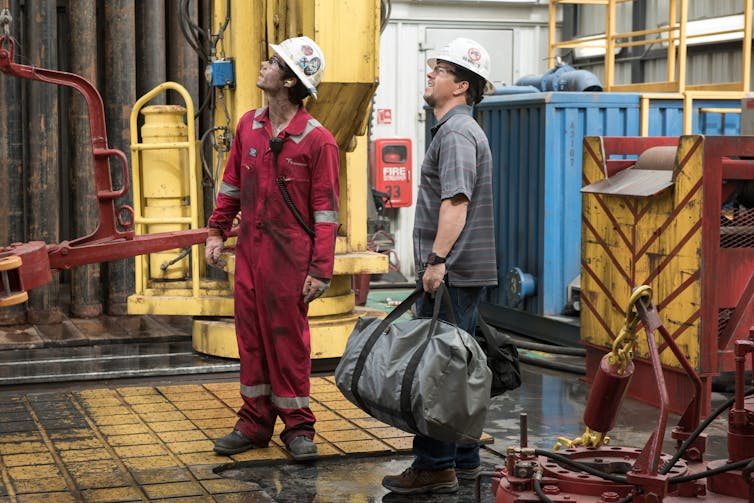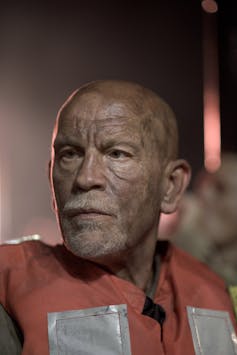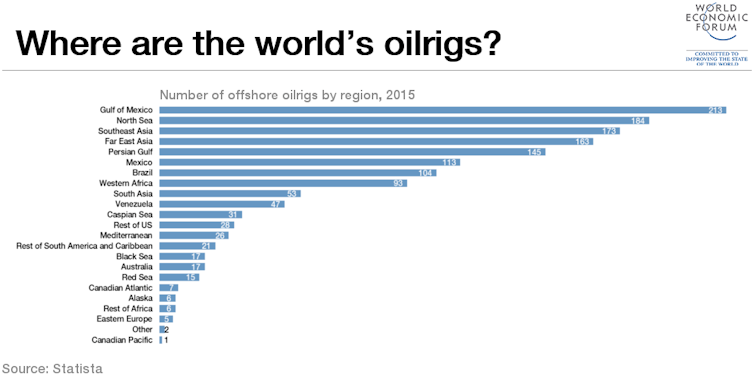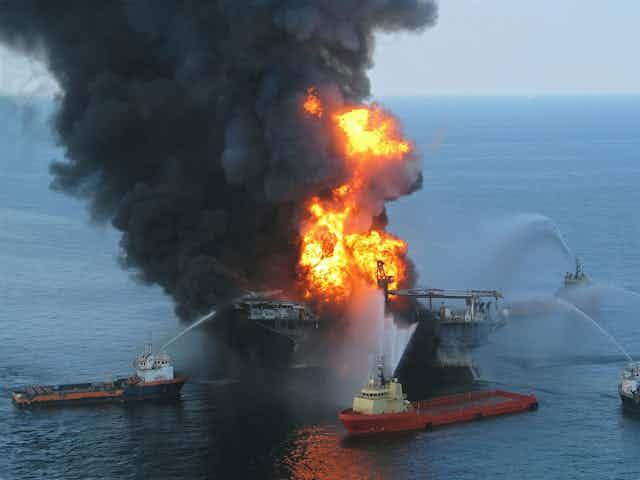When I went to see the movie “Deepwater Horizon” with some of my graduate students last week, I did not expect accuracy. Drilling for oil and gas is not typically viewed favorably or depicted correctly in Hollywood movies.
When I tell non-oilfield people that I am a professor of petroleum engineering, someone usually brings up the dreadful movie “Armageddon,” in which Bruce Willis’ character, Harry Stamper (“the best deep-sea driller in the world”), is coerced into giving up his offshore drilling job to embed a nuclear bomb into an asteroid that threatens all life on Earth. Conditions on Stamper’s rig, with explosions hurling people through the air, bear little resemblance to the safe, well-controlled environment that one finds on virtually all deepwater rigs around the world.
I had other reasons for low expectations. Most people seem to remember that the Macondo/Deepwater Horizon blowout (more about this terminology below) caused the worst environmental oil spill in U.S. history, but forget that it also killed 11 offshore workers. The idea of Hollywood profiting from sensationalizing this tragedy seemed quite inappropriate to me.
In the dedicated class that I teach on this disaster, I stress not only that many technical mishaps contributed to it, but also that leadership failures – largely by BP, the company that owned the well – allowed the blowout to occur. I did not think it would be possible to explain the complexities and nuances in a two-hour movie. And I worried that the film would not convey the fact that virtually all of today’s deepwater wells are safely constructed.
Overall, though, my students and I agreed that “Deepwater Horizon” deserves its largely positive reviews. The movie gets a number of points about the blowout wrong, but it accurately depicts the atmosphere on an offshore drilling rig. It is also a fitting testament to the workers who died in this disaster, and to others who are working to make offshore drilling safer today.

Technical failures and bad decisions
There are many inaccuracies in “Deepwater Horizon.” Some are small: For example, Mike Williams, chief electronics technician for Transocean (Mark Wahlberg), barrels down a flight of stairs on the rig carrying his luggage without holding any handrails, which would be a clear violation of Transocean safety policy. Other errors are much larger: The movie depicts gas breaking out around the wellhead even before the blowout event, but such a “broach” of gas to the seafloor never occurred.
Like investigations of the event, the movie focuses primarily on the ill-fated and malfunctioning blowout preventer – the device designed to seal any fluids and gas beneath it and prevent them from coming to surface. But it ignores many important facts that are essential to understanding why the blowout occurred.
As just one example, BP made an ad-hoc and, in hindsight, poorly informed decision to circulate a fluid waste mixture into the well instead of disposing of it as waste onshore. Operators sought to use the fluid as a “spacer” to separate seawater from dense drilling mud in the well, but the solids-laden fluid may have plugged a critical line and skewed results from two “negative tests” that were designed to verify that the well was tightly sealed. The movie shows confused rig staff trying to interpret the test results, but offers no explanation.
The movie also gives short shrift to the implications of removing the weighted column of mud that forms a primary barrier against oil and gas rising in the well. This mud barrier is removed when drillers plug and abandon a well, but the process can precipitate a blowout if oil and gas formations deep in the well are not properly sealed with steel casing and cement. In the film, Mike Williams’ young daughter explains the process using a soda can and straw as props, resulting in a “soda blowout.” This scene comes very early, passes in an instant, and many viewers may not grasp its significance.
More broadly, the title of the movie is wrong: it should be “Macondo” (or at least “Macondo/Deepwater Horizon”), since Macondo was the name of the well that blew out. “Deepwater Horizon” was the name of the Transocean semi-submersible drilling rig that BP leased. As the movie shows, this rig had safely drilled numerous wells before Macondo. Names do matter: In the aftermath of the disaster, BP consistently referred to it as the “Deepwater Horizon” event, apparently trying to shift blame to Transocean.
Heroes and villains
On the positive side, “Deepwater Horizon” cleverly tells a human story through the eyes of Mike Williams, who becomes the hero once the rig catches fire and lives are at stake.
The casting is excellent, and I recognized the workers’ camaraderie and sense of duty from my own experience working offshore in the Gulf of Mexico. “Deepwater Horizon” also captures the often-tense relationship between the oil company operator (in this case, BP) and the rig contractor (here, Transocean) which often makes it difficult for the latter to go against the former’s wishes. Kurt Russell is excellent as the frustrated offshore installation manager, James “Mr. Jimmy” Harrell, and Mark Wahlberg’s performance is good enough to forgive him for not just one but two “Ted” movies.
Some performances are almost too good. John Malkovich portrays BP well site leader Donald Vidrine as a sly, uncaring villain, and the movie pins responsibility for the blowout squarely on Vidrine and rig supervisor Robert Kaluza, played by Brad Leland.

Vidrine and Kaluza were indicted after the spill for involuntary manslaughter, based on their negligent supervision of two negative tests. In the movie Vidrine attributes high pressure in the drill pipe during the first negative test to an illogical “bladder effect,” and overrules Transocean on the second negative test.
The truth is more complicated. The “bladder effect” hypothesis was raised by a Transocean crew member , not by BP, to explain ambiguities in the second negative test, not the first. (In general, “Deepwater Horizon” takes Transocean’s side of the story; I believe this perspective is appropriate, but filmmakers still should strive for balance and accuracy.)
Moreover, the blowout did not result from a single bad decision, but from a whole series of events that allowed barriers meant to prevent a catastrophic event to become compromised. In my view, most of this happened due to poor decisions by BP managers, both at the rig site and in the office, who were trying to curtail spending on a well that was behind schedule and significantly over budget.
“Deepwater Horizon” shows one example, when BP sends a Schlumberger crew home without performing a cement bond log – a measurement to verify the presence and quality of the cement used to seal the oil and gas-bearing rock formations. Without a bond log, there was no way to verify the presence of cement, let alone its quality.
Many viewers will be outraged to learn at the end of “Deepwater Horizon” that manslaughter charges against Vidrine and Kaluza were dismissed in 2015. But these men represented an organization with a culture of cost-cutting and excessive risk-taking that also was responsible for a deadly explosion at a Texas City refinery in 2005 and a massive oil spill from the Trans-Alaska Pipeline in 2006. By portraying Vidrine and Kaluza as the only guilty parties, “Deepwater Horizon” ignores the larger failure of BP’s corporate leadership.
Despite these flaws, “Deepwater Horizon” is worth seeing and will certainly provoke questions. My students wanted to know much more about both technical issues and leadership mistakes after seeing the movie. Asking these questions will serve them very well in preparing them for future leadership roles in this global industry.

The offshore industry has made significant safety improvements since the Macondo/Deepwater Horizon tragedy, and the Interior Department has adopted a new well control rule that sets tighter standards for offshore well construction. More work remains to be done, however.
For my part, I hope this movie will lead to better public understanding of exactly what happened on April 20, 2010, and serve as a permanent reminder to all stakeholders involved to remain vigilant to prevent a repeat occurrence.

